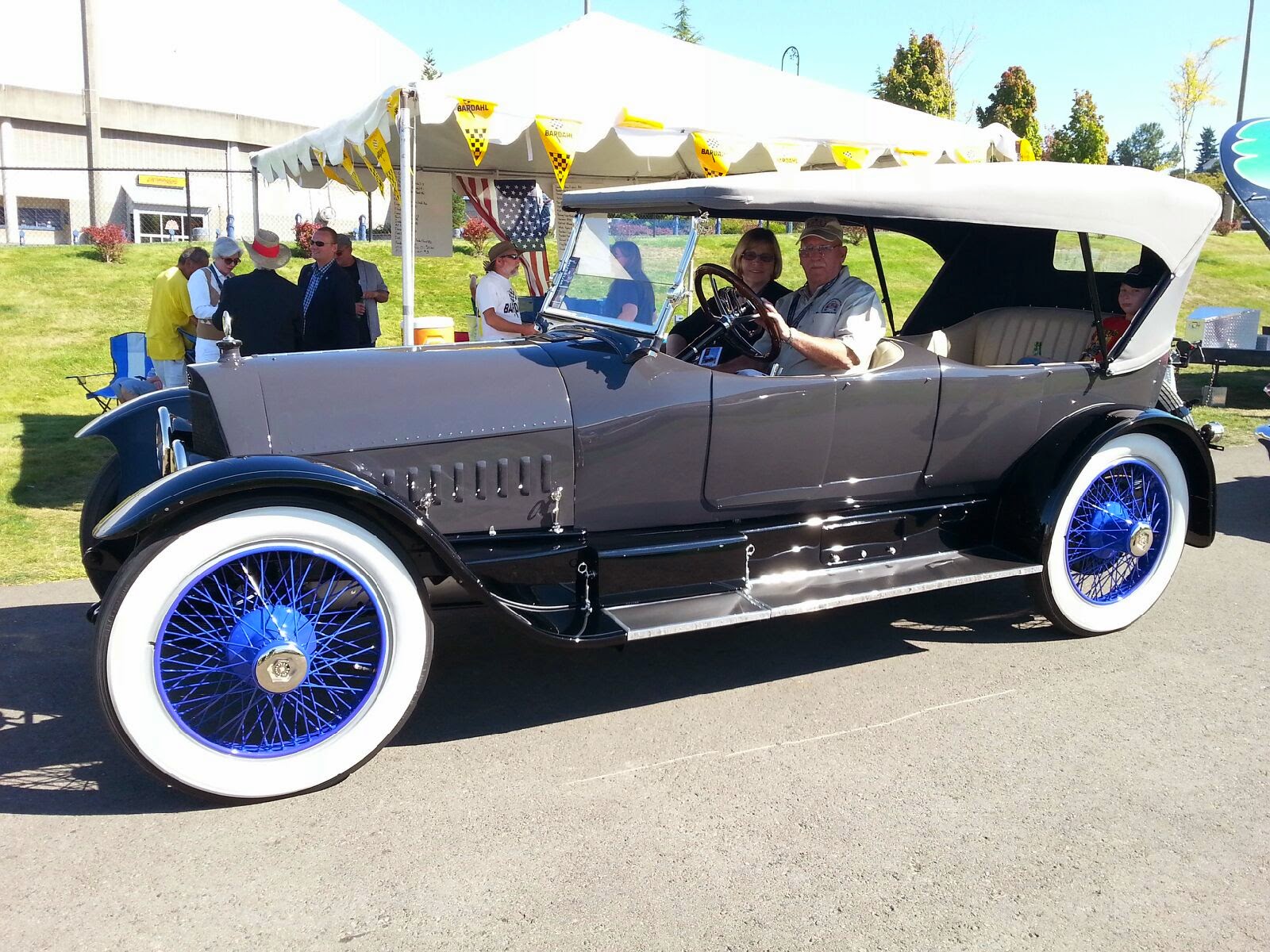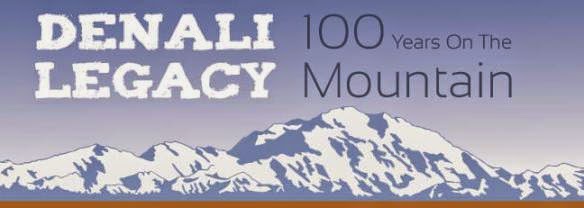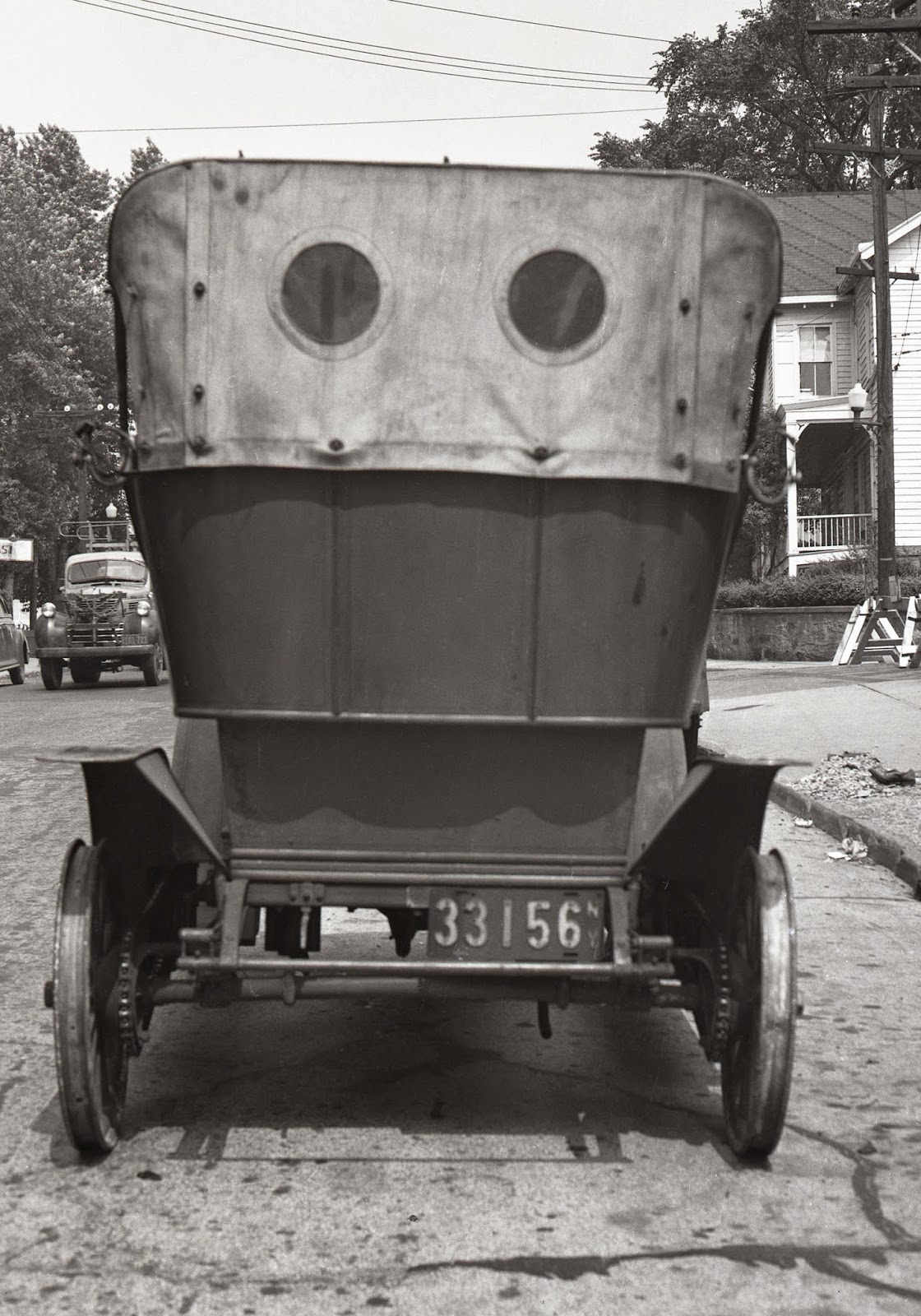by Nancy DeWitt
© Fountainhead Antique Auto Museum
![]() Earlier this year Frances Erickson, daughter of Alaska automotive pioneer Robert Sheldon, loaned me some of her family photos to scan. Among them was this one of a most unusual-looking bus, resembling a stretched-out limousine. Frances recalled that Bobby used it to transport tourists into Mt. McKinley National Park and that it was very upscale and dependable.
Earlier this year Frances Erickson, daughter of Alaska automotive pioneer Robert Sheldon, loaned me some of her family photos to scan. Among them was this one of a most unusual-looking bus, resembling a stretched-out limousine. Frances recalled that Bobby used it to transport tourists into Mt. McKinley National Park and that it was very upscale and dependable.
Naturally, I was curious as to what kind of bus this was. I found a second photo of it in Snapshots from the Past: A Roadside History of Denali National Park and Preserve, and it clearly showed the name “Fageol” on the radiator. Thus began some internet research, which led me to John Fageol (pronounced “fadgl,” rhymes with “fragile”), a descendent of one of the brothers who founded Fageol Motors Co. in Oakland, CA. John identified it as a ca. 1924+ Fageol “Intercity” Safety Coach with a cast aluminum cowling and Gruss shocks in front. It had a seating capacity of 22 and a wheelbase of 218 inches. Each bench seat had its own door, disappearing wide window, interior light, and adjustable side and ceiling vents. A “parlor” model carried movable wicker chairs, attached to the floor by suction cups. One of these can be seen at the Museum of Bus Transportation in Hershey, PA.
![]() It turns out the Fageol Safety Coach, the first bus built from the ground up, was quite revolutionary. Until its introduction in 1921, most buses were built on stiff-riding truck chassis, and their poor ride quality, high centers of gravity, and low-performance engines made them unsatisfactory for transit use. Fageol coaches had a double-drop frame and underslung axles, which lowered the floor to 21 inches above the ground and an overall height of just 76 inches. Power was initially supplied by a Hall-Scott single overhead cam 4-cylinder engine designed by Fageol. Each one came equipped with all-weather tread cord tires, with duals on the rear. An extra-wide tread of 72 inches between the wheels provided extra stability on turns. Beginning in 1923, Fageols were equipped with air brakes, the first use of such on a motor coach. The interior was heated by hot water from the engine, run through pipes along the floor.
It turns out the Fageol Safety Coach, the first bus built from the ground up, was quite revolutionary. Until its introduction in 1921, most buses were built on stiff-riding truck chassis, and their poor ride quality, high centers of gravity, and low-performance engines made them unsatisfactory for transit use. Fageol coaches had a double-drop frame and underslung axles, which lowered the floor to 21 inches above the ground and an overall height of just 76 inches. Power was initially supplied by a Hall-Scott single overhead cam 4-cylinder engine designed by Fageol. Each one came equipped with all-weather tread cord tires, with duals on the rear. An extra-wide tread of 72 inches between the wheels provided extra stability on turns. Beginning in 1923, Fageols were equipped with air brakes, the first use of such on a motor coach. The interior was heated by hot water from the engine, run through pipes along the floor.
![]() Frances told me that Bobby and his partners were forced by the Park Service to close their transportation concession in 1941, and the bus was sold to the Alaska Railroad. The ARR brought it to Fairbanks, where it sat rotting in a lot on Davis Road. When I mentioned this to Willy, he said, “I remember seeing it there!” In fact, a number of people in Fairbanks remembered seeing it, but no one seemed to know of its history. Willy and I went by the lot Frances described, but it was fenced and we could see no sign of the old coach. Willy left a note on the gate, and several months later he finally heard from the owner.
Frances told me that Bobby and his partners were forced by the Park Service to close their transportation concession in 1941, and the bus was sold to the Alaska Railroad. The ARR brought it to Fairbanks, where it sat rotting in a lot on Davis Road. When I mentioned this to Willy, he said, “I remember seeing it there!” In fact, a number of people in Fairbanks remembered seeing it, but no one seemed to know of its history. Willy and I went by the lot Frances described, but it was fenced and we could see no sign of the old coach. Willy left a note on the gate, and several months later he finally heard from the owner.
![]() Not only was the Fageol still there, but owner Diane Dawson said she would donate it to the museum! I had assumed it was black, but red paint is still present on the aluminum panels. The distinctive ventilation louvres on top of the hood—a key Fageol design feature—are intact. The Hall-Scott engine and Brown-Lipe 4-speed gearbox with an overdrive top gear are still under the hood. The high-grade leather seats are long gone, except for some seat frames. Much of the wooden framework has rotted and the side panels have collapsed. The running board, which sits just 16 inches above the ground, is still fairly intact.
Not only was the Fageol still there, but owner Diane Dawson said she would donate it to the museum! I had assumed it was black, but red paint is still present on the aluminum panels. The distinctive ventilation louvres on top of the hood—a key Fageol design feature—are intact. The Hall-Scott engine and Brown-Lipe 4-speed gearbox with an overdrive top gear are still under the hood. The high-grade leather seats are long gone, except for some seat frames. Much of the wooden framework has rotted and the side panels have collapsed. The running board, which sits just 16 inches above the ground, is still fairly intact.
![]() Around 2,500 Fageol Safety Coaches were built, and there are only five known survivors in addition to this one. Clearly, ours is in bad shape, but a rare artifact like this deserves to be saved. We moved it to the Fountainhead Development headquarters earlier this month, and will work to stabilize and preserve its remains, rather than try to restore it.
Around 2,500 Fageol Safety Coaches were built, and there are only five known survivors in addition to this one. Clearly, ours is in bad shape, but a rare artifact like this deserves to be saved. We moved it to the Fountainhead Development headquarters earlier this month, and will work to stabilize and preserve its remains, rather than try to restore it.
Calloway, Dick. “Fageol: A Higher Standard.” Wheels of Time (American Truck Historical Society), July/August 2013.
“Fageol Motors Co., Fageol Truck and Coach Co., Fageol Motors Co. of Ohio.“ Retrieved on 5 September 2014 from http://www.coachbuilt.com/bui/f/fageol/fageol.htm
Herman, Gene. “ The Fageol Safety Coach: A Breakthrough in Bus Design.” The Old Motor, 15 January 2014. Retrieved on 5 September 2014 from theoldmotor.com /?p=111779
Juneau, Bud. “Safety Coach: Fageol’s Innovative, Trendsetting Coach of 1927.” Special Interest Autos, September/October 2001.
Coming to Fairbanks to see the Fountainhead Antique Auto Museum and other area attractions? Support the museum by staying right here at Wedgewood Resort. All guests receive half-price admission to the museum!
© Fountainhead Antique Auto Museum
 Earlier this year Frances Erickson, daughter of Alaska automotive pioneer Robert Sheldon, loaned me some of her family photos to scan. Among them was this one of a most unusual-looking bus, resembling a stretched-out limousine. Frances recalled that Bobby used it to transport tourists into Mt. McKinley National Park and that it was very upscale and dependable.
Earlier this year Frances Erickson, daughter of Alaska automotive pioneer Robert Sheldon, loaned me some of her family photos to scan. Among them was this one of a most unusual-looking bus, resembling a stretched-out limousine. Frances recalled that Bobby used it to transport tourists into Mt. McKinley National Park and that it was very upscale and dependable. Naturally, I was curious as to what kind of bus this was. I found a second photo of it in Snapshots from the Past: A Roadside History of Denali National Park and Preserve, and it clearly showed the name “Fageol” on the radiator. Thus began some internet research, which led me to John Fageol (pronounced “fadgl,” rhymes with “fragile”), a descendent of one of the brothers who founded Fageol Motors Co. in Oakland, CA. John identified it as a ca. 1924+ Fageol “Intercity” Safety Coach with a cast aluminum cowling and Gruss shocks in front. It had a seating capacity of 22 and a wheelbase of 218 inches. Each bench seat had its own door, disappearing wide window, interior light, and adjustable side and ceiling vents. A “parlor” model carried movable wicker chairs, attached to the floor by suction cups. One of these can be seen at the Museum of Bus Transportation in Hershey, PA.
 It turns out the Fageol Safety Coach, the first bus built from the ground up, was quite revolutionary. Until its introduction in 1921, most buses were built on stiff-riding truck chassis, and their poor ride quality, high centers of gravity, and low-performance engines made them unsatisfactory for transit use. Fageol coaches had a double-drop frame and underslung axles, which lowered the floor to 21 inches above the ground and an overall height of just 76 inches. Power was initially supplied by a Hall-Scott single overhead cam 4-cylinder engine designed by Fageol. Each one came equipped with all-weather tread cord tires, with duals on the rear. An extra-wide tread of 72 inches between the wheels provided extra stability on turns. Beginning in 1923, Fageols were equipped with air brakes, the first use of such on a motor coach. The interior was heated by hot water from the engine, run through pipes along the floor.
It turns out the Fageol Safety Coach, the first bus built from the ground up, was quite revolutionary. Until its introduction in 1921, most buses were built on stiff-riding truck chassis, and their poor ride quality, high centers of gravity, and low-performance engines made them unsatisfactory for transit use. Fageol coaches had a double-drop frame and underslung axles, which lowered the floor to 21 inches above the ground and an overall height of just 76 inches. Power was initially supplied by a Hall-Scott single overhead cam 4-cylinder engine designed by Fageol. Each one came equipped with all-weather tread cord tires, with duals on the rear. An extra-wide tread of 72 inches between the wheels provided extra stability on turns. Beginning in 1923, Fageols were equipped with air brakes, the first use of such on a motor coach. The interior was heated by hot water from the engine, run through pipes along the floor. Frances told me that Bobby and his partners were forced by the Park Service to close their transportation concession in 1941, and the bus was sold to the Alaska Railroad. The ARR brought it to Fairbanks, where it sat rotting in a lot on Davis Road. When I mentioned this to Willy, he said, “I remember seeing it there!” In fact, a number of people in Fairbanks remembered seeing it, but no one seemed to know of its history. Willy and I went by the lot Frances described, but it was fenced and we could see no sign of the old coach. Willy left a note on the gate, and several months later he finally heard from the owner.
Frances told me that Bobby and his partners were forced by the Park Service to close their transportation concession in 1941, and the bus was sold to the Alaska Railroad. The ARR brought it to Fairbanks, where it sat rotting in a lot on Davis Road. When I mentioned this to Willy, he said, “I remember seeing it there!” In fact, a number of people in Fairbanks remembered seeing it, but no one seemed to know of its history. Willy and I went by the lot Frances described, but it was fenced and we could see no sign of the old coach. Willy left a note on the gate, and several months later he finally heard from the owner. Not only was the Fageol still there, but owner Diane Dawson said she would donate it to the museum! I had assumed it was black, but red paint is still present on the aluminum panels. The distinctive ventilation louvres on top of the hood—a key Fageol design feature—are intact. The Hall-Scott engine and Brown-Lipe 4-speed gearbox with an overdrive top gear are still under the hood. The high-grade leather seats are long gone, except for some seat frames. Much of the wooden framework has rotted and the side panels have collapsed. The running board, which sits just 16 inches above the ground, is still fairly intact.
Not only was the Fageol still there, but owner Diane Dawson said she would donate it to the museum! I had assumed it was black, but red paint is still present on the aluminum panels. The distinctive ventilation louvres on top of the hood—a key Fageol design feature—are intact. The Hall-Scott engine and Brown-Lipe 4-speed gearbox with an overdrive top gear are still under the hood. The high-grade leather seats are long gone, except for some seat frames. Much of the wooden framework has rotted and the side panels have collapsed. The running board, which sits just 16 inches above the ground, is still fairly intact. Around 2,500 Fageol Safety Coaches were built, and there are only five known survivors in addition to this one. Clearly, ours is in bad shape, but a rare artifact like this deserves to be saved. We moved it to the Fountainhead Development headquarters earlier this month, and will work to stabilize and preserve its remains, rather than try to restore it.
Around 2,500 Fageol Safety Coaches were built, and there are only five known survivors in addition to this one. Clearly, ours is in bad shape, but a rare artifact like this deserves to be saved. We moved it to the Fountainhead Development headquarters earlier this month, and will work to stabilize and preserve its remains, rather than try to restore it.The Fageol buses manufactured for Safety Coach Lines of Muskegon, Michigan, were nicknamed "greyhounds" because of their gray paint and sleek appearance. One legend says this inspired the name of what became America’s most well-known bus line.
Who would have thought an old rusty bus could be so interesting?
Who would have thought an old rusty bus could be so interesting?
Sources:
“Fageol Motors Co., Fageol Truck and Coach Co., Fageol Motors Co. of Ohio.“ Retrieved on 5 September 2014 from http://www.coachbuilt.com/bui/f/fageol/fageol.htm
Herman, Gene. “ The Fageol Safety Coach: A Breakthrough in Bus Design.” The Old Motor, 15 January 2014. Retrieved on 5 September 2014 from theoldmotor.com /?p=111779
Juneau, Bud. “Safety Coach: Fageol’s Innovative, Trendsetting Coach of 1927.” Special Interest Autos, September/October 2001.
Coming to Fairbanks to see the Fountainhead Antique Auto Museum and other area attractions? Support the museum by staying right here at Wedgewood Resort. All guests receive half-price admission to the museum!




















































































